DC Comics Presents Elseworlds 100-Page Spectacular One-Shot (DC Comics, $7.99)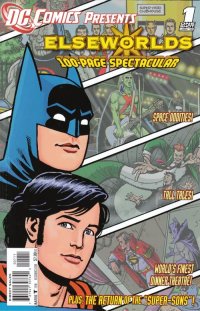
by Graig Kent
Back in the late 1990’s DC Comics released a spate of “80-Page Giants”, thick, squarebound one-shot anthologies housing short stories that would otherwise have no home. One of these Giants was an “Elseworlds”, DC Comic’s “What If…?” imprint wherein its characters “…are taken from their usual setting and put into strange times and places — some that have existed, and others that can’t, couldn’t or shouldn’t exist.” The imprint lasted about 15 years, and yielded a few highlights, like Kingdom Come, The Golden Age, Thrillkiller and a few others, but by and large the Elseworlds output was forgettable.
The “Elseworlds 80-Page Giant” became a standout for two reasons: first, because it was notoriously stopped on the presses by DC’s then Publisher Paul Levitz (purportedly objecting to Kyle Baker’s “Letitia Lerner, Superman’s Babysitter” story in which baby Clark winds up in a microwave at one point) only to have a few hundred copies leak out to the UK market; second, because Baker then went on to win not one, but two Eisner awards for the story, which quickly went viral on-line.
“Letitia Lerner…” went on to be reprinted (or printed anew) in the Bizzaro Stories anthology 2001, and the Bob Haney written “Return of the Super-Sons” (reviving one last time the hypothetical duo of Batman Jr. and Superman Jr. which Haney dabbled with in the World’s Finest title back in the 70’s) landed in the “Saga of the Super-Sons” trade paperback (2007) but the remainder of the tales remained only in the hands the e-bay traders.
I’m not certain what prompted DC Comics to dust off the collection and include it in its “DC Comics Presents” line of reprints but it is certainly a welcome curiosity, if not altogether a successful one.
The opening tale, “The Reaching Hand” by D. Curtis Johnson (whose Chase series gets reprinted in trade this week) and Aaron Lopresti takes Bruce Wayne into Lovecraftian territory as this gothic-30’s-set tale finds the detective narrating his investigation into a rash of mysterious deaths, leading to haunting dreams and ultimately finding a few familiar names and faces. It’s a fun little spin that tries hard — and marginally succeeds — at avoiding parody, despite the gag surprise reveal and ending. With a bit more refinement, the Bruce Wayne as gothic paranormal investigator would have made for an entertaining full 64-page prestige-format story.
In “Rockumentary” writer Bronwyn Carlton attempts to answer what it would be like if the heroes and villains of the DCU were part of the (pre-Napster) music industry but has nothing interesting to say about the industry or the characters involved in it. It exists primarily as an idea, a terribly executed idea. It doesn’t help that the art and character designs from Greg Luzniak are equally unimaginative and bland.
Baker’s “Leticia Lerner” is an homage to the Looney Toons/Tom and Jerry-style over-the-top violence, and executed to perfection. It’s hard to imagine that 12 years ago comics were so much more touchy that a genuinely silly tale such as this would stir up so much of a fuss as to both pulp the printing of a comic as well as rouse Eisner voters to rally behind it (not to slight at all Baker’s ceaselessly impressive cartooning).
Chuck Dixon and Enrique Villagran reinvent the Birds of Prey into a soap operatic comic strip in “The Vigilantes in Apartment 3-B” (satirizing the classic Apartment 3-G newspaper strip). Dixon nails both the tone of romance strips and of adventure/superhero strips while Villagran’s work is pitch perfect in style (though it would have been even more spot on were it in black and white). More than any other story in this collection, I wanted more of this.
What I find most interesting about “Superman Jr. Is No More” is how only a true veteran of the era, like Bob Haney, can accurately recreate the tone and style of storytelling of the time without making it overtly campy but also relying a tremendous amount on camp by its mere conceit. It’s a fine line the post-silver age veterans tread to make something both cornball and entertaining and without a hint of irony. Kieron Dwyer is a perfect match on art even if it seems like rushed work at times.
“Scandalgate” is a pithy look at cable news partisanship that would have been far more mind blowing prior to Jon Stewart’s taking over of the Daily Show, then 12 years hence. Still, a very entertaining two pages from Tom Peyer and Ty Templeton.
Chuck Dixon puts in a second effort with “Worlds Apart”, a grim take on “What If… Kal-El’s spacecraft crash landed on Bruce Wayne’s parents.” It’s a brief 7 pages, which, for the absurdity of the conceit, is still a few pages too long. The art from Tevor Von Eeden is ugly, though taking on heavy inspiration from Frank Miller. It’s a gag on Dixon’s part, but a purposeless and nihilistic one.
Mark Waid and Ty Templeton bring 8 “Silver Age Elseworlds First Pages” which is comic book nerd humor at its finest. Cheesy, absurd, and loving every minute of it, from a Metallo Superman-as-John Wilkes Booth assassinating a Brainiac Lincoln to an underwater Batman and Robin the Squid Wonder.
Tom Peyer doles out a second tale with “Dark Night Of The Golden Kingdom”, a thinly-veiled parody of Kingdom Come featuring a Vegas-bound fat-Elvis-inspired Superman. It’s a decidedly bizarre, Morrison-esque tale which is either brilliant or stupid… but with some gorgeous rendering from Ariel Olivetti, I’m leaning heavily towards the former.
The final tale is actually an additional toss-in to bolster the “80-Page Giant” into a “100-Page Spectacular”, reprinting a short story by Paul Pope that originally appeared in the quarterly anthology Batman Chronicles #11 in 1998. Here Pope envisions what Bob Kane’s Batman might have been like were he created in Germany in 1939. Pope is, to say the least, a unique storyteller in his field, in every sense of the word. His visual craft is his own, but his ideas, his pacing, his structure, they’re all tellingly Paul Pope at every turn. There’s never mistaking his work for anyone else, and “Batman In Berlin” is Pope equally playful and pensive.
As with any anthology, it’s an uneven affair, at times trapped in the era of its making, with occasional allusions to the DCU of the period as well as a couple of workmanlike efforts from industry stalwarts, and yet, the good stuff is so enjoyable that it actually makes it worthwhile, and something worth revisiting, in part at least.
Rating: 




Out of a Possible 5 Stars
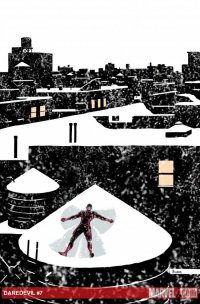 Daredevil #7 (Marvel Comics, $2.99)
Daredevil #7 (Marvel Comics, $2.99)
By Bart Bishop
It’s well documented that Mark Waid’s current run on Daredevil is aiming to be more positive after a decade of all star writers (Smith, Bendis, Rucka, Brubaker, Diggle) putting Matt Murdock through the wringer. A new direction was needed. Having not read the first six issues, this felt like a good jumping on point to check out the new optimism. Unfortunately, while the artwork and dialogue are crackling, the plot is too precocious and depends on contrived mechanics to put the titular character in a position of weakness for the sake of drama.
Matt Murdock has been volunteering with the Cresskill School for the Blind, and while on a trip to the mountains the bus gets caught in a blizzard and crashes. Murdock, super senses dulled by the snow, has to guide the children to safety. This is contrasted by the events leading up to the trip, a holiday party at Nelson & Murdock Law Firm, in which Murdock banters with Assistant District Attorney Kristen McDuffie. Much fun is had at the expense of Murdock’s plausible deniability in relation to being Daredevil.
Here’s where the dialogue really shines. Waid understands the voices of classic characters like Matt Murdock and Foggy Nelson who, at this point, have been published almost continuously for fifty years. He manages to keep them consistent but self aware and therefore able to evolve, as with a nice bit of meta-commentary when Murdock disregards “the tortured, guilt ridden self-destructive punching bag” he used to be and chooses instead to be the life of the party. McDuffie is also being set up as a new love interest; not only is she portrayed as a smart, strong challenge to Murdock, but this plays into his womanizing ways, exemplifying how a good writer understands that Murdock can’t help but be impulsive no matter how much he wants to change.
It’s the rest of the issue that’s a let-down. The circumstances of the bus crashing are forced, as Murdock senses the bus driver in distress far ahead of time and doesn’t act. The danger of the kids being lost in the storm is nicely developed, as is the reasons for Murdock to be in Daredevil costume and the children not noticing, but the resolution is unearned. The panicky children suddenly finding the strength to act has little set up, and there’s a missed opportunity at an arc for Murdock. His inability to control the situation could have said a lot about his lack of faith in others, and the children saving him could’ve taught him a lesson about trust, but it just happens. There’s nice irony, but little message about strength or teamwork.
The artwork, however, is exemplary. The cover is a beautiful, counterintuitive image, of Daredevil making a snow angel on a rooftop. The sparse use of color creates a clean image that says much about the character’s current concerns: he’s happy, found a purpose and identity again, and is very much at home in his city. That is, however, another missed opportunity as nothing is made of Murdock being a big city man suddenly thrown into the wilderness. The inside recap is a nice touch, as well, as it takes the form of the front page of the Daily Bugle newspaper. Not only is this helpful for new readers, but draws on Murdock’s history with such reporter characters as Ben Urich and Peter Parker.
The rest of the issue shows how Paolo Rivera needs to be a breakout artist in the comic industry. He has a classic, almost cartoony style but has a strong sense of weight and scale. His panel layouts evoke the mood of the action (the bus crashing portrays panic, with multiple snapshots spread across a splash page) very well, while quiet moments of human interaction have unique expressions and thoughtful non sequitirs. I also appreciate the stylized depiction of Murdock’s radar sense, giving the reader a glimpse into the alien world of super powered disability like never before.
Mark Waid has long been a favorite of mine. His work in mainstream superheroes is some of the best around, although it generally goes unnoticed next to the more showy writers. Paolo Rivera is an artist now on my radar, as he provides a synthesis of timeliness and contemporary sensibility. Although I admit confusion at a few plot points (Murdock staring at what appears to be a Fantastic Four symbol, Murdock’s father’s grave collapsing into the ground at the end), this issue in particular is a nice standalone story. It’s a good jumping on point for new readers, even if it’s not the highlight of the run so far.
[Rating; 3.5]
Brody’s Ghost One Shot (Dark Horse, $3.99)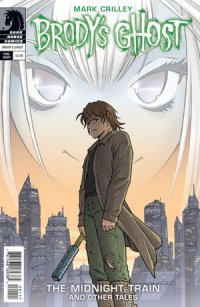
By D. S. Randlett
Like a lot of comics readers, I sort of bob and weave out of the market depending on money, time, and interest. I was lured back into comics by DC’s wave of new 52 titles, talked about them on the lovely CHUD Forum, and kindly got asked to write reviews for Thor’s Comic Column. Having been away from comics for a few years, I’ve managed to miss a lot, like the debut of Akiko creator Mark Crilley’s latest creation, Brody’s Ghost. That I had missed it was news to me, as I saw this one shot on the stands, which collects four short stories originally published in Dark Horse Presents, I had assumed that it was a completely new title. Not much later, I discovered that there were already two trade paperbacks collected.
So, basically being in the same position as a reader of Dark Horse Presents a year or two ago, I’m in the position to ask myself whether or not I want to go forward with these characters and this story.
As this is a preview for a longer series, the main thing that the reader gets are some tastes of the general tone, and the voices of the characters. As far as this one shot is concerned, those are big positives. While Crilley’s art has a definite manga look, it feels a lot like some of the TMNT comics I’d read as a kid. There is a sense of darkness, danger, and the macabre, but all the same there’s a sort of warm and cozy feeling, like going camping in some scary woods with good friends. From the brief exposure to the characters here, it’s pretty obvious that Crilley has a command over their voices and a vision for them. Despite being confined to a set of stories that basically run like jokes, he’s able to establish a pretty impressive sense of identity.
Still, it’s hard to recommend this one shot on its own as anything other than an enticement for the main series. Some of the quirkiness present here ends up feeling a bit shallow, and none of the stories have much to offer in the way of plot. That’s simply not enough content for the money, unless you’re already a fan of this series and want some material that you somehow missed.
Those trades, and any future issues of Brody’s Ghost are looking mighty enticing, though.
Rating: 




Out of a Possible 5 Stars
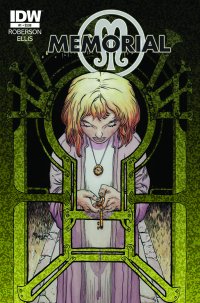 Memorial #1 (IDW Publishing, $3.99)
Memorial #1 (IDW Publishing, $3.99)
By Bart Bishop
Neil Gaiman has had a huge impact on the comic book medium since the inception of Sandman twenty years ago, and the first issue of Memorial attests to that. Unfortunately, writer Chris Roberson uses all the surface trappings of Gaiman’s whimsical fantasy tales without understanding what makes them work. This issue comes across as rushed, racing to cram much borrowed mythology into little space without bothering with things like characters or pacing. This is unfortunate, as I’m a big fan of Roberson’s iZombie.
Memorial starts with a young woman stumbling into a hospital. She has amnesia, and ends up taking the name Em after the simple “M” on her necklace. This is a solid basis for a mystery, but immediately the omniscient narrator starts spoiling secrets. There’s an abrupt jump to a mystical realm called Everglade, with arbitrary exposition about it being formed of stolen memories. This does little to differentiate the setting from Wonderland, Oz, or Gaiman’s own The Dreaming.
A year passes, with Em having somehow settled into a new life without a social security number or birth certificate. She stumbles upon a fancy key in an antiques shop, which is somehow connected to at least two other silly realms called “Forecastle” and “Ruritania”…and then my eyes started to glaze over. This attempt at world building should be awe inspiring, but instead comes across as perfunctory and derivative. There’s nothing here that hasn’t been done a million times before, and better.
Still, artist Rich Ellis does an adept job at handling the multitudes thrown at him. His rounded, softer style captures big cities (the solicitation claims Portland, Oregon, but you wouldn’t know from the comic itself) as well as magical happenings, and brings a style and creativity that the writing lacks. Background details create a mystique and hint at a bigger universe, which is exactly what a story like this needs. The antique shop, especially, is a bizarre bazaar that I want to get lost in. The posters coming to life late in the issue is a nice touch, as well as the strange mythological creatures and talking cat. The cover is also a striking image, very reminiscent of Charles Vess’ work, although the little girl that must be Em is a blond while the character within the comic is a brunette.
I give IDW credit for allowing something like this to be published. The company has consistently strayed from superheroes, although it does tend to lean on adaptations (GI Joe, Star Trek) of pre-existing material. In that way the company reminds me of Dark Horse in the early ‘90s, struggling to make a dent in a market dominated by the Big Two, Marvel and DC. Still, attempts need to be made at originality rather than mimicking the success of other companies.
It’s disappointing that Roberson has created a vista upon which anything can happen, and has ended up doing the same old thing. There’s potential for infinite possibilities in later issues that can ease into the plot and characters with more grace and finesse, but I’ll wait for the word of mouth on that.
Rating: 




Out of a Possible 5 Stars
Secret Avengers #20 (Marvel, $3.99)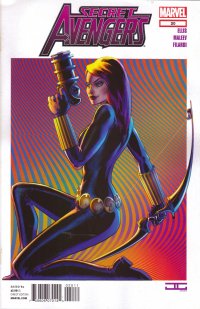
By Jeb D.
Given his imposing, eccentric reputation, it’s not hard to picture Warren Ellis down the pub, knocking off his work-for-hire Marvel stuff in between pints, while declaiming to all and sundry about the stifling influence of superheroes on the field of sequential fiction. But, really, the paycheck cape gig for him is actually pretty rare (and it’s arguable that even something like Ultimate Fantastic Four was as much a last-minute favor to his pals Bendis and Millar as anything else). That’s not to say that he never puts a foot wrong, or that his spandex work hasn’t been known to disappear up its own backside now and again (see Astonishing X-Men), but for the most part, his best Marvel work (including Thunderbolts and Iron Man: Extremis) has taken good advantage of the opportunities to blend a bit of sci-fi, and a dab of politics, into the ‘splode.
His run on Secret Avengers has been generally solid, but with this issue, he absolutely nails it. The premise is, so to speak, time-honored: a mission has gone badly wrong; several Avengers are dead; only the Black Widow survives, and she’s seeking a way to put things right-which, in superhero terms, means we’re talking time-travel.
But rather than simply make this yet another tale of millennial ping-pong, Ellis makes this a story not so much about time-traveling, but about the concept of time-travel, examining its potential and contradictions both for the actions of anyone who attempted it, and the meta-textual problems it poses for the writer employing it-rather like the never-explained “fictionaut” of Planetary; and, in fact, this issue has a stronger vibe of that series than anything Ellis has given us in some time. In some ways, Natasha Romanoff serves here as a stand-in for Jakita Wagner, raising an eyebrow at the dithering of science and its quest for arcane knowledge: she just wants the damn time-machine to work, and her commentary and observations (including the exasperated conversation she carries on with one of her futuristic devices) bring just the right touch of astringent realism. And while I continue to be suspicious of the idea that “old-fashioned done-in-one” storytelling is the answer to the industry’s woes, this is a great example of doing it right.
While the Black Widow has received loving treatment from a host of artists over the years (with my farovites including Gene Colan, Bill Siekewicz, Sean Phillips, and Terry Moore), no one captures her blend of cold professionalism, intimidating brilliance, and passion for adventure any better than Alex Maleev. There’s a level of experimentation here that’s reminiscent of his brilliant work on Scarlet, but he’s not above tossing in a two-page battle spread that Bryan Hitch would be proud of.
I only have one reservation: if we had a scoring system with quarter-stars, I’d definitely knock one off for John Cassaday’s cheesy Planetary-lite style cover, which really conveys nothing whatsoever about the tone of the book. But it’s not worth docking the book a full half-star, as long as you don’t let it stop you from picking up a terrific piece of comic entertainment.
Rating: 




Out of a Possible 5 Stars